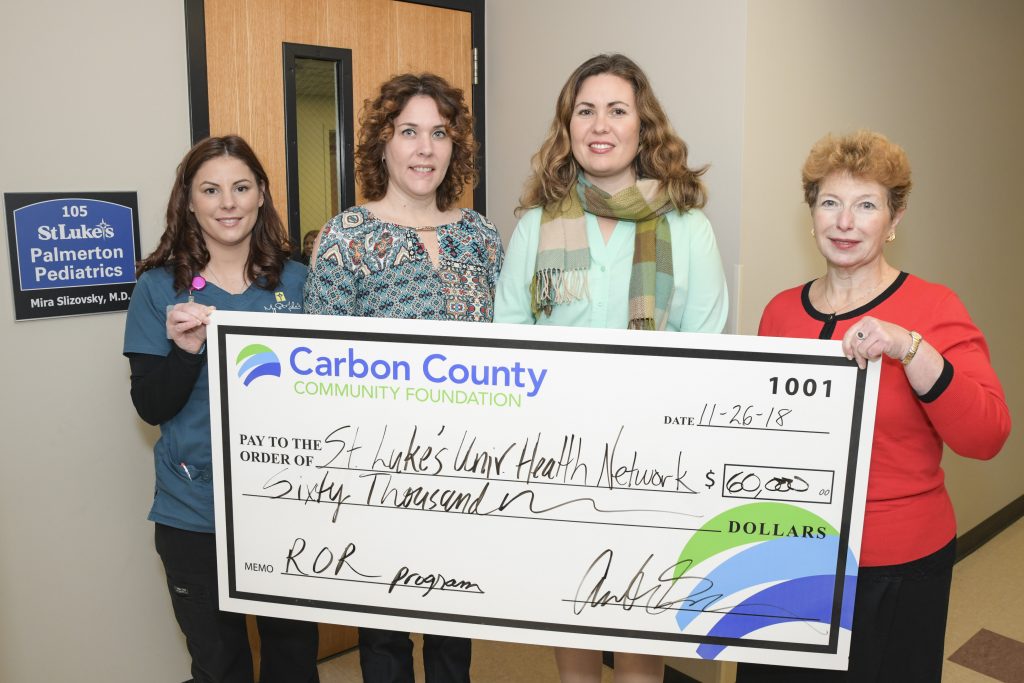St. Luke’s Reach Out and Read program has received a $60,000 grant from a Donor-Advised Fund at the Carbon County Community Foundation. St. Luke’s University Health Network, a longtime partner of Reach Out and Read, will use the money to help meet the literacy needs of pediatric patients in Carbon County.
“We’re proud and honored to act on behalf of a donor who understands the power of literacy and wanted to make a meaningful impact on the lives of children here in Carbon County,” said Amber Breiner, Executive Director of Carbon County Community Foundation. Donor-Advised Funds at the Community Foundation present a simple and cost-effective way for people to give strategically to the causes they care about most and receive as little or as much recognition as desired.
Reach Out and Read (ROR) prepares America’s youngest children to succeed in school by training doctors and nurses to advise parents about the importance of reading aloud and by giving books to children at checkups from 6 months through 5 years. Through Reach Out and Read, each child starts kindergarten with a home library of up to 10 new, carefully chosen books and a parent who has heard at every health supervision visit about the importance of books and reading.
“This project has the potential to impact 1,500 children ages 6 months to 5 years in Carbon County in one year,” said Rosemarie Lister, Community Health Liaison for SLUHN. Participating practices are: Palmerton Pediatrics, Lehighton Family Practice, Nesquehoning Primary Care and Nesquehoning Rural Health Center.

From left to right: Jennifer DeJesus, St. Luke’s Palmerton Pediatrics Medical Assistant;Tammy Lobach, CRNP, St. Luke’s Nesquehoning Rural Health Center; Amber Breiner, Executive Director, Carbon County Community Foundation; Dr. Mira Slizovsky, MD, St. Luke’s Pediatric Associates
Healthcare providers attend a one-hour continuing medical education course online on how to instruct parents on techniques for reading aloud to their children and the importance of making reading a fun part of daily life, Lister said. The program emphasizes teaching families how to enjoy looking at board books and naming pictures with infants, the importance of using rhyme and repetition with toddlers, and asking open-ended questions when reading with preschoolers. ROR not only encourages reading, but singing, talking and playing as well.
Promoting oral health part of the program
Also, as part of the grant, St. Luke’s Community Health will be providing books and materials that promote oral health literacy as Carbon County is located in a dental health provider shortage area. ROR provides an opportunity to align with the American Academy of Pediatrics Brush, Book and Bed Program where families can learn more ways to value oral health through fun and engaging reading.
“Studies show that building early literacy is critical to developing reading ability and succeeding in school and life,” said Dianne Jacobetz, MD, FAAP, St. Luke’s Physician Group, Regional Medical Director of Pediatrics. “This grant enables our providers to teach parents about the importance of reading aloud with their children every day and give developmentally appropriate books to children. It is a wonderful opportunity for both St. Luke’s family healthcare providers and families in Carbon County.”
About Reach Out and Read
Reach Out and Read was founded in 1989 with its first program at Boston City Hospital (now Boston Medical Center). By 2001, dramatic growth brought the Reach Out and Read model to all 50 states, with almost 1,500 sites distributing 1.6 million books per year. Today, Reach Out and Read partners with more than 5,800 program sites and distributes 6.9 million books per year. The program currently serves one in four children living in poverty in this country.
About St. Luke’s
Founded in 1872, St. Luke’s University Health Network (SLUHN) is a fully integrated, regional, non-profit network of more than 14,000 employees providing services at 10 hospitals and more than 300 outpatient sites. With annual net revenue greater than $2 billion, the Network’s service area includes 10 counties: Lehigh, Northampton, Berks, Bucks, Carbon, Montgomery, Monroe and Schuylkill counties in Pennsylvania and Warren and Hunterdon counties in New Jersey. Dedicated to advancing medical education, St. Luke’s is the preeminent teaching hospital in central-eastern Pennsylvania. In partnership with Temple University, St. Luke’s created the region’s first and only regional medical school campus. It also operates the nation’s longest continuously operating School of Nursing, established in 1884, and 28 fully accredited graduate medical educational programs with 226 residents and fellows. St. Luke’s is the only health care system in central-eastern Pennsylvania to earn Medicare’s five-star rating (the highest) for quality, efficiency and patient satisfaction. St. Luke’s has earned the 100 Top Major Teaching Hospital designation from IBM Watson Health (formerly Truven Health Analytics) repeatedly – six times total and four years in a row including 2018. It has also been cited by IBM Watson Health as a 50 Top Cardiovascular Program. Utilizing the EPIC electronic medical record (EMR) system for both inpatient and outpatient services, the Network is a multi-year recipient of the Most Wired award recognizing the breadth of the SLUHN’s information technology applications such as telehealth, online scheduling and online pricing information. St. Luke’s is also recognized as one of the state’s lowest cost providers.
Early Childhood Literacy Matters:
%
Approximately 80% of Human Brain Development Takes Place by Age 3
est. # of children in Carbon County served by the new Reach Out and Read program
Early Language and Vocabulary Skills are Linked to Future Success
“Chronic stressors in early childhood, such as poverty, can have cumulative lifetime effects on learning, earnings, and health. Language differences associated with socioeconomic status have been documented as early as age 18 months. Vocabulary skills by age 3 years predict third grade reading, which in turn predicts high school graduation rates. High school graduates have increased earning potential… and are also more likely to report good health and visit a health professional, important markers of positive health outcomes.” — from 2017 CDC report Grand Rounds: Addressing Health Disparities in Early Childhood